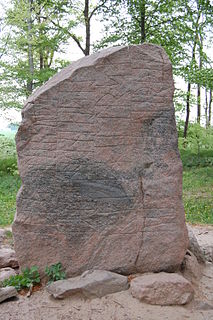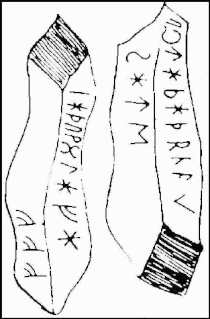Related Research Articles

Týr is a god in Germanic mythology. In Norse mythology, which provide most of the surviving narratives about gods among the Germanic peoples, Týr sacrifices his hand to the monstrous wolf Fenrir, who bites it off when he realizes the gods have bound him. Týr is foretold of being consumed by the similarly monstrous dog Garmr, during the events of Ragnarök.

In Norse mythology, Eir is a goddess or valkyrie associated with medical skill. Eir is attested in the Poetic Edda, compiled in the 13th century from earlier traditional sources; the Prose Edda, written in the 13th century by Snorri Sturluson; and in skaldic poetry, including a runic inscription from Bergen, Norway from around 1300. Scholars have theorized about whether these three sources refer to the same figure, and debate whether Eir may have been originally a healing goddess or a valkyrie. In addition, Eir has been theorized as a form of the goddess Frigg and has been compared to the Greek goddess Hygieia.

In Norse mythology, a valkyrie is one of a host of female figures who choose those who may die in battle and those who may live. Selecting among half of those who die in battle, the valkyries take their chosen to the afterlife hall of the slain, Valhalla, ruled over by the god Odin. There, the deceased warriors become einherjar. When the einherjar are not preparing for the events of Ragnarök, the valkyries bear them mead. Valkyries also appear as lovers of heroes and other mortals, where they are sometimes described as the daughters of royalty, sometimes accompanied by ravens and sometimes connected to swans or horses.
In Norse mythology, Vár or Vór is a goddess associated with oaths and agreements. Vár is attested in the Poetic Edda, compiled in the 13th century from earlier traditional sources; the Prose Edda, written in the 13th century by Snorri Sturluson; and kennings found in skaldic poetry and a runic inscription. Scholars have proposed theories about the implications of the goddess.

Mjölnir is the hammer of the thunder god Thor in Norse mythology, used both as a devastating weapon and as a divine instrument to provide blessings. The hammer is attested in numerous sources, including 11th century runic Kvinneby amulet, and the Poetic Edda, a collection of eddic poetry compiled in the 13th century, and the Prose Edda, a collection of prose and poetry compiled in the 13th century. The hammer was commonly worn as a pendant during the Viking Age in the Scandinavian cultural sphere, and Thor and his hammer occur depicted on a variety of objects from the archaeological record. Today the symbol appears in a wide variety of media and is again worn as a pendant by various groups, including adherents of modern Heathenry.
The Bryggen inscriptions are a find of some 670 medieval runic inscriptions on wood and bone found from 1955 and forth at Bryggen in Bergen, Norway. It has been called the most important runic find in the twentieth century. Before the find of these inscriptions, there was doubt whether the runes were ever used for anything else than inscriptions of names and solemn phrases. The Bryggen find showed the everyday use that runes had in this area, and presumably in other parts of Scandinavia as well. Another important aspect of the find was that many of the inscriptions were obviously at least as recent as the 14th century. Previously it was believed that the use of runes in Norway had died out long before.

The sequence alu is found in numerous Elder Futhark runic inscriptions of Germanic Iron Age Scandinavia between the 3rd and the 8th century. The word usually appears either alone or as part of an apparent formula. The symbols represent the runes Ansuz, Laguz, and Uruz. The origin and meaning of the word are matters of dispute, though a general agreement exists among scholars that the word represents an instance of historical runic magic or is a metaphor for it. It is the most common of the early runic charm words.

Kragehul I is a migration period lance-shaft found on Funen, Denmark. It is now in the collection of the National Museum of Denmark, Copenhagen, Denmark. The spear shaft was found in 1877 during the excavation of the classic war booty sacrificial site Kragehul on southern Funen. The site holds five deposits of military equipment from the period 200 to 475 AD. The spear shaft probably belongs to the latest deposit.

The Ledberg stone, designated as Ög 181 under Rundata, is an image-stone and runestone located in Östergötland, Sweden.

The Ring of Pietroassa or Buzău torc is a gold torc-like necklace found in a ring barrow in Pietroassa, Buzău County, southern Romania, in 1837. It formed part of a large gold hoard dated to between 250 and 400 CE. The ring itself is generally assumed to be of Roman-Mediterranean origin, and features a Gothic language inscription in the Elder Futhark runic alphabet.

The Skarpåker Stone, designated by Rundata as Sö 154, is a Viking Age memorial runestone that originally was located in Skarpåker, Nyköping, Sörmland, Sweden. It dates to the early eleventh century.

There is some evidence that, in addition to being a writing system, runes historically served purposes of magic. This is the case from earliest epigraphic evidence of the Roman to Germanic Iron Age, with non-linguistic inscriptions and the alu word. An erilaz appears to have been a person versed in runes, including their magic applications.

The Glavendrup stone, designated as DR 209 by Rundata, is a runestone on the island of Funen in Denmark and dates from the early 10th century. It contains Denmark's longest runic inscription and ends in a curse.

The Saleby Runestone, designated as Vg 67 in the Rundata catalog, was originally located in Saleby, Västra Götaland County, Sweden, which is in the historic province of Västergötland, and is one of the few runestones that is raised in memory of a woman.

The Gummarp Runestone, designated as DR 358, was a runestone from the Vendel era and which was located in the former village of Gummarp in the province of Blekinge, Sweden.
The Charnay Fibula is a mid-6th century fibula or brooch which was discovered in Burgundy in 1857. It has a runic inscription consisting of a horizontal partial listing of the first twenty of the twenty-four rune sequence of the Elder Futhark:
The "Nine Herbs Charm" is an Old English charm recorded in the tenth-century CE Anglo-Saxon medical compilation known as Lacnunga, which survives on in the manuscript London, British Library, Harley 585. The charm involves the preparation of nine plants. The numbers nine and three, significant in Germanic paganism and later Germanic folklore, are mentioned frequently within the charm. The poem contains references to Christian and English Pagan elements, including a mention of the major Germanic god Woden.

The Setre Comb is a bone comb found in 1932 at Setre in Bømlo, Norway, which has been dated to between 560 and 700 AD. It has a runic inscription whose interpretation has been extensively discussed.
Ragnhild Tregagås or Tregagás was a Norwegian woman from Bergen. In 1324/1325 she was accused and convicted for exercising witchcraft. She was sentenced to strict fasting and a seven-year-long pilgrimage to holy places outside of Norway. The trial against Ragnhild Tregagås is the only one concerning witchcraft that is known from medieval Norway, taking place 250 years before the witch-hunt in Norway started.

The Narsaq stick is a pine twig inscribed with runic symbols dating to ca. 1000. The stick was discovered in Narsaq in Greenland in 1953 and was quickly seen as a significant find, as it was the first Viking Age runic inscription discovered in Greenland. The stick has two sentences of ambiguous and obscure runic text. One suggested interpretation of the first sentence is "He who sat on a tub saw a tub" while another is "On the sea, the sea, the sea is the ambush of the Æsir". The other sentence refers to a maiden named "Bibrau" who may be sitting on the sky. The runic alphabet is carved on one side of the stick in a short-twig form. Yet another side has a series of carefully carved symbols of unclear meaning, possibly cipher runes or some sort of tally.
References
- Macleod, Mindy. Mees, Bernard (2006). Runic Amulets and Magic Objects . Boydell Press ISBN 1-84383-205-4